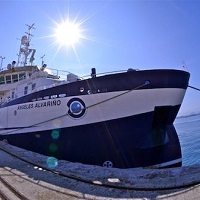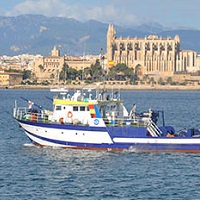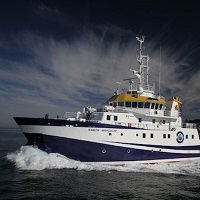Keyword
underwater cameras
78 record(s)
Type of resources
Categories
Topics
INSPIRE themes
Keywords
Contact for the resource
Provided by
Years
Formats
Status
-

Research and identification of sunken vessels
-

El objetivoEl objetivo de la campaña es instalar tres estaciones de colectores de post-larvas de langosta Palinurus elephas en la zona litoral (<25m) en la Isla de Menorca.
-

Estimate Nephrops norvegicus abundance in the gulf of Cadiz by underwater video recordings.
-

1.- Se pretende ubicar en la estricta verticalidad del pecio un barco de tecnología moderna que tenga la posibilidad de transportar y hacer operativo un ROV. Dicho ROV deberá ser capaz de descender hasta los 1200 metros del objetivo, y pasar varias horas de trabajo diarias filmando y fotografiando los restos del pecio. Por lo tanto debe entenderse que la clara finalidad de esta Campaña estriba en la documentación, “mapeado” arqueológico e interpretación y análisis del estado actual del pecio. 2.- Además de lo anterior, se pretende realizar la cartografía de la zona de hundimiento de la Fragata Nuestra Señora de Las Mercedes. Para ello, con la sonda multihaz EM710 se llevará a cabo un levantamiento batimétrico sistemático de la zona del hundimiento con recubrimiento redundante solapando al 100%, con los haces cerrados al máximo y velocidad no superior a 5 nudos. De estemodo, se consigue una elevada densidad de puntos sondados que permitirá realizar una cartografía de gran resolución.
-

Mantenimiento de los colectoresprofundos de langosta, obtención de larvas filosomas y filmaciones submarinas con video cebado.
-

Se pretende continuar con las labores acometidas en la Primera Campaña realizada en el 2015 en lo referido al conocimiento del pecio: - Extensión del pecio. - Estado de conservación de los materiales. - Dispersión de los restos del buque español. - Continuar con el “mapeado” arqueológico. - Avanzar en la interpretación y análisis del pecio. - Extracción de los siguientes elementos, basada en motivaciones de carácter histórico‐culturales, museográficas, de conservación, archivísticas y jurídicas: a.‐ Culebrina de bronce del siglo XVI. Peso aproximado: entre 1.300 y 1.800 Kg. b.‐ Un “cañón pedrero” u “obús de a tres”, de bronce. Pareja del extraído en 2015. c.‐ Elementos de la vajilla de plata estropeada (plata de chafalonía) que figura en la documentación del AGI. d.‐ También se extraerán algunos elementos que en el 2015 se filmaron y cuya función desconocemos. e.‐ Dependiendo de las circunstancias de la Campaña, es posible que se proceda a extraer la segunda culebrina de la Mercedes.
-

Mantenimiento de los colectoresprofundos de langosta, obtención de larvas filosomas y filmaciones submarinas con video cebado.
-

Monitoring the conservation status of vulnerable ecosystems of the MPA of “El Cachucho”, including identification and mapping of habitats and characterization of benthic communities
-

The main objective foreseen in the ECOMARG 2021 campaign, to be carried out on board the R/V Ángeles Alvariño (IEO), is the study of the spatial distribution, structure and dynamics of vulnerable habitats of the ZEC “El Cachucho” (Le Danois Bank and its internal basin) and the head of the nearby Lastres canyon. Specific objectives: • Estimation of the abundance and spatial distribution of the epibenthic communities that characterize the vulnerable habitats present in the area, with special priority for the classified as 1170 Reefs in the DH. • Monitoring of the conservation status of vulnerable habitats and their communities biological, using fixed sampling stations, through indicators of the Red Natura 2000, in accordance with article 17 of the Habitats Directive, applying technical photogrammetric. • Geophysical study of the Lastres and Llanes canyons by obtaining cartography high resolution. • Characterization of the oceanographic dynamics of the BBL (Benthic Boundary Layer - layer near the bottom) in the Gaviera Canyon and in the fixed sampling stations from El Cachucho to know the environmental characteristics of the habitats 1170. • Study of the mobile species (mainly fish, crustaceans, and mollusks) of the Vulnerable habitats present at fixed sampling stations using platforms multiparametric (landers).
-

1. To obtain estimates of Nephrops burrows densities in the Gulf of Cádiz from a randomized isometric grid of UWTV stations spacing 4 nautical miles using the underwater images. 2. To define the Nephrops distribution in the Gulf of Cádiz 3. To obtain density estimates of bentho-demersal macrofauna species 4. To calibrate bentho-demersal macrofauna observed in the underwater videos and those obtained in the beam trawl. 5. To obtain and the occurrence of trawl marks on the sea bed 6. To measure oceanographic variables using a sledge mounted CTD 7. To collect sediment samples 8. To prospect circalittoral and bathyal areas without trawling activity 9. Sea bed morphological and backscatter analyses
 Catálogo de datos del IEO
Catálogo de datos del IEO